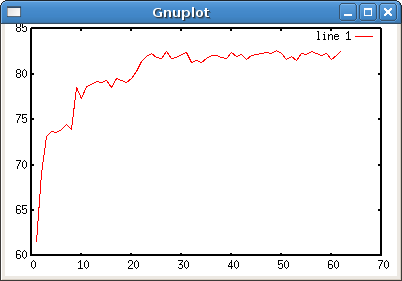nullprogram.com/blog/2007/11/13/
Get the source code (C++):
This is a neural network I wrote for an artificial intelligence class
I took about a year ago. It includes a stand alone neural network
class you can easily use in your own C++ program. Built around this
neural network is a simple version of Blackjack (hit or stand only).
You can play the neural network at Blackjack after it has finished
training, which can take up to a minute or so.
My implementation of the neural network is a really simple one, using
only back propagation, but it still has some neat surprises in it.
When I was working with it, I would use a simple GNU Octave script to
watch what was going on in real time.

The x-axis is the number of iterations in tens of thousands and the
y-axis describes how often the neural network plays exactly the same
way a cheater would at the same seat. A cheater is defined as someone
who knows what card is next and can play perfectly. Note: the neural
network itself is not cheating. At the end, it agrees with the cheater
about 83% of the time. This is the script that reads the neural
network output. For those who don’t recognize the
she-bang, save this to the file plotdat and
set the execution permission (chmod +x plotdat).
#!/usr/bin/octave -qf
# Usage:
# plotdat filename [loop] [last index]
dat = dlmread(argv{1});
x = length(dat);
loop = 0;
if (length(argv) > 1)
if (argv{2} == 'loop')
loop = 1;
else
x = argv{2};
end
end
plot(dat(1:x));
while(loop)
dat = dlmread(argv{1});
plot(dat);
sleep(1);
end
pause;
When you run the program, a blank, dumb neural network is created. It
doesn’t know how to play blackjack. In fact, just as it seems with my
sister at times, it doesn’t know how to do anything at all. It’s like
a newborn baby, but without any instincts. To make this neural network
useful, it is taught to play blackjack by running it very quickly
through about one million games, all tutored by a teacher who gets to
cheat by looking ahead in the deck. This allows the teacher to always
know the proper move.
The training works by giving the network an input and the desired
output (determined by the cheating). The network adjusts its internal
weights depending on the error between what its current output for the
input and the desired output. In doing this, the neural network picks
up on the statistical nature of its inputs and will pick up on
patterns.
When setting up the neural network in your own program, the tricky
part is determining how to encode the inputs so that patterns will be
found. In this case, I provide 3 integers to the network: its lower
bound score, its best score, and the visible opponent score. By lower
bound and best score, I am talking about Aces. All aces are treated as
1’s in the lower bound and ideal (highest without bust) values in the
best score. Scores never exceed 31, so we can encode this in 5 bits
each for a total of 15 bits. We only need 1 output bit: hit (0) or
stand (1). The network looks something like this, but with 30 hidden
layer neurons and a lot more connections.

Here is an example run of the blackjack game,
Creating network ... created!
Training ...
Win, lose, total, c%, win%: 1536, 7640, 10000, 42.1168% , 15.36%
Win, lose, total, c%, win%: 3728, 14438, 20000, 55.8875% , 21.92%
... (lots of output for a few seconds) ...
Win, lose, total, c%, win%: 203744, 700338, 980000, 82.0455% , 20.3%
Win, lose, total, c%, win%: 205849, 707461, 990000, 82.5488% , 21.05%
Win, lose, total, c%, win%: 207981, 714515, 1000000, 82.3059% , 21.32%
Begin game:
Computer is dealt: (hole) 5
Computer is dealt: (hole) 5 4
Computer stands.
Your hand: 2 8
Hit? (y/n): y
Your hand: 2 8 3
Hit? (y/n): y
Your hand: 2 8 3 10
You bust with 23
Computer wins with 19 against your 23
Play again? (y/n) : y
Begin game:
Computer is dealt: (hole) 4
Computer is dealt: (hole) 4 10
Computer stands.
Your hand: 10 A
Hit? (y/n): n
Your hand: 10 A
You win with 21 against computer's 20
Play again? (y/n) : n
Computer wins, losses, push: 1 (50%), 1 (50%), 0 (0%)
If you decide to try using the neural network in your own program, be
sure to play with different sized networks to see what works best. In
my implementation, a small network would be 1 layer with 3 nodes and a
large network would be 3 or 4 layers with hundreds of nodes. Bigger
networks may not work well at all, and there is no way to know what
size is best other than trial and error.